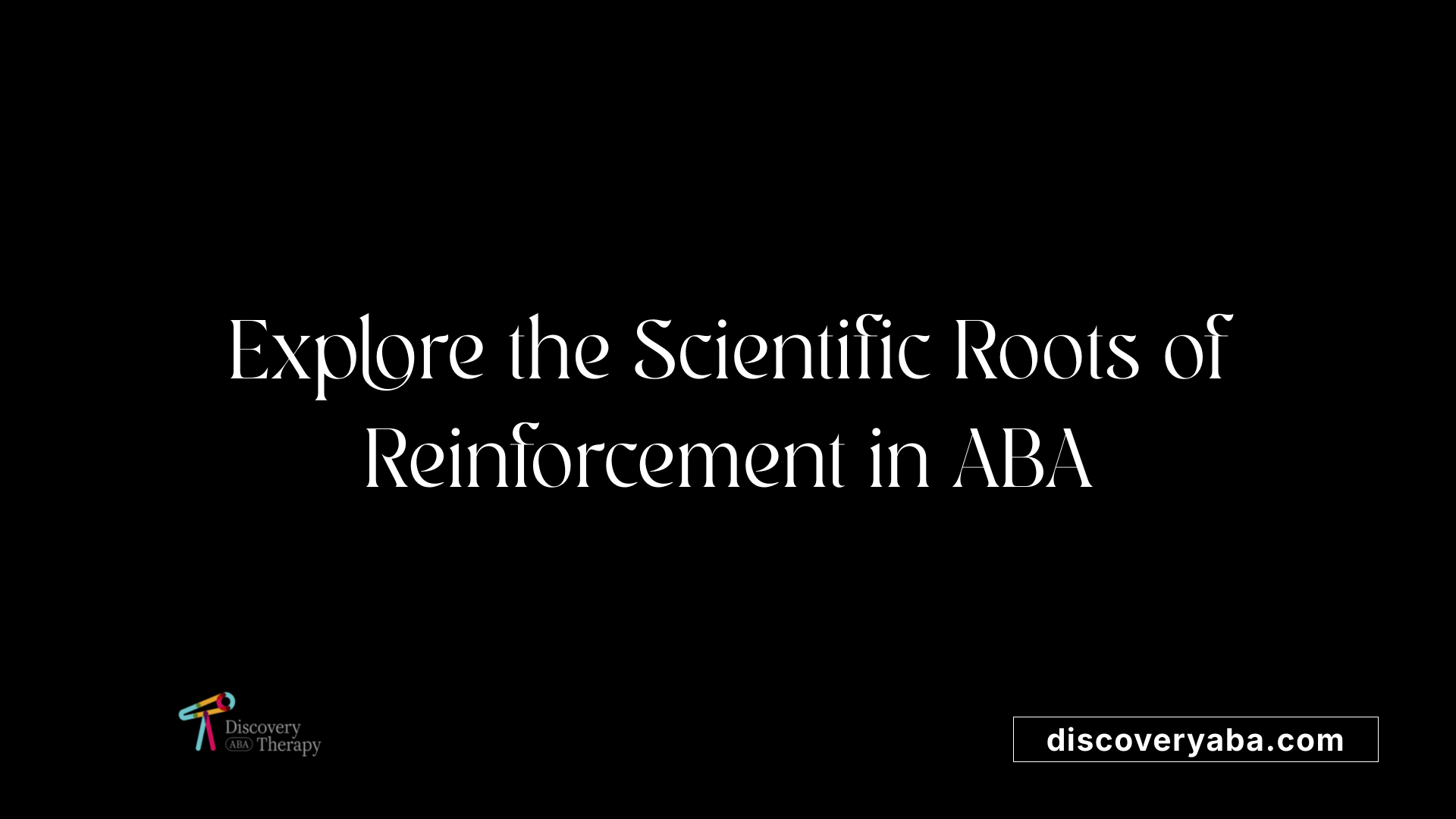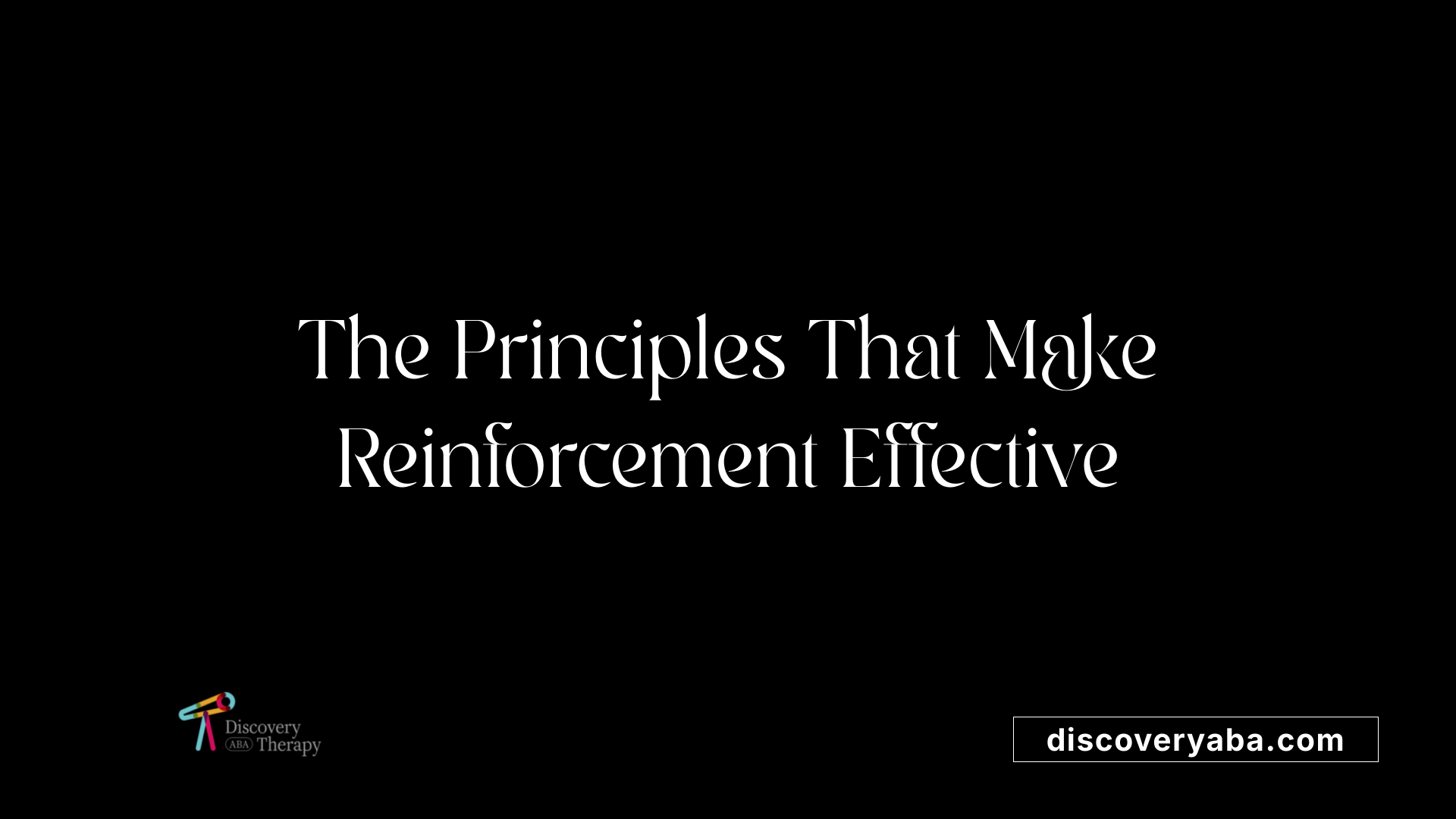The science behind reinforcement in ABA therapy
Understanding the Foundations of Reinforcement in Behavioural Therapy

An In-depth Look into the Core Principles of Reinforcement in ABA
Reinforcement sits at the heart of Applied Behavior Analysis (ABA), underpinning its systematic approach to behaviour modification. Grounded in scientific theories like operant and classical conditioning, reinforcement mechanisms are meticulously designed to effect meaningful, lasting behaviour change. This article explores the scientific principles that support reinforcement strategies in ABA, examining how they operate, their various forms, and the empirical evidence validating their effectiveness.
The Scientific Foundations of Reinforcement in ABA

What is reinforcement in ABA and what is its scientific basis?
Reinforcement in Applied Behavior Analysis (ABA) is a method used to increase the likelihood that a specific behavior will happen again. It works by providing a consequence after the behavior, which can be adding something pleasant (positive reinforcement) or removing an unpleasant stimulus (negative reinforcement).
The scientific roots of reinforcement come from operant conditioning, a theory pioneered by psychologist B.F. Skinner. This theory explains how behaviors can be influenced by their consequences and is built on the earlier Law of Effect proposed by Edward Thorndike. The Law of Effect states that behaviors followed by satisfying outcomes are more likely to be repeated, laying the groundwork for understanding how reinforcement works.
In ABA, reinforcers are categorized into two main types: primary and secondary. Primary reinforcers include natural, innately rewarding stimuli such as food and water, which fulfill basic needs. Secondary reinforcers are learned, conditioned stimuli like tokens, praise, or privileges that acquire value through association.
Reinforcement schedules are strategies that determine how often and when reinforcement is delivered. For example, continuous reinforcement provides reinforcement after every occurrence of the behavior, which is useful during initial learning. Partial reinforcement schedules, like fixed ratio or variable interval, are used to strengthen behaviors and promote persistence over time.
Research consistently supports these principles, demonstrating that reinforcement effectively modifies behaviors across different environments, including schools, clinics, and homes. Its scientific foundation ensures that ABA techniques are grounded in validated methods, leading to meaningful and lasting behavior change.
The Different Types of Reinforcement in ABA
 Reinforcement is a foundational element of applied behavior analysis (ABA) that effectively shapes and maintains desirable behaviors. In ABA, reinforcement is generally divided into two main types: positive and negative.
Reinforcement is a foundational element of applied behavior analysis (ABA) that effectively shapes and maintains desirable behaviors. In ABA, reinforcement is generally divided into two main types: positive and negative.
Positive reinforcement involves adding a pleasant stimulus immediately after a behavior to increase the likelihood that the behavior will occur again. For example, giving a child a favorite sticker or praise when they complete a task encourages them to repeat that behavior. It creates a positive association and motivates learning.
Negative reinforcement, on the other hand, entails removing an unpleasant or aversive stimulus to promote a specific behavior. An example would be stopping a loud noise when a child completes their homework, which encourages the child to complete the task to avoid discomfort.
To sustain motivation and ensure behaviors are learned consistently, ABA practitioners utilize various reinforcement schedules. These schedules determine when reinforcement is delivered and can be classified as continuous, fixed, or variable intervals.
- Continuous reinforcement provides reinforcement after every correct response, ideal during initial learning phases.
- Fixed schedules deliver reinforcement after a set number of responses or a fixed amount of time, fostering consistent responses.
- Variable schedules reinforce responses after unpredictable or variable amounts of responses or time, which helps maintain behavior over the long term.
Reinforcers can be tangible, social, or activity-based, tailored to individual preferences for maximum effectiveness.
- Tangible reinforcers include items like toys, stickers, or tokens.
- Social reinforcers consist of praise, high-fives, or verbal encouragement.
- Activity-based reinforcers offer access to preferred activities, such as playing a game or watching a favorite show.
Using immediate reinforcement after a behavior is crucial for strengthening learning and reducing maladaptive behaviors. Reinforcement strategies are personalized and often integrated into broader interventions, including video modeling, prompting and fading, natural environment teaching, and behavior contracts.
Ultimately, selecting the right type and schedule of reinforcement, along with appealing reinforcers, leads to meaningful progress. It helps individuals acquire new skills, reduces challenging behaviors, and supports the generalization of learned behaviors across different settings and situations.
Learning Theories and Reinforcement Mechanisms

How does reinforcement function within learning theories like operant and classical conditioning?
Reinforcement acts as a fundamental process in both operant and classical conditioning, shaping how behaviors are learned and maintained.
In operant conditioning, which forms the basis of applied behavior analysis (ABA), reinforcement is used to increase the likelihood of a behavior reoccurring. This can be achieved through positive reinforcement—adding a pleasant stimulus, such as praise or treats when a desired action is performed—or negative reinforcement, where an unpleasant stimulus is removed to encourage the behavior, like turning off a loud noise when someone completes a task. This approach emphasizes active participation, where the individual learns through the consequences that follow their actions.
On the other hand, classical conditioning involves forming associations between stimuli that trigger involuntary responses. For example, Pavlov’s experiments with dogs showed that when a neutral stimulus, like a bell, was repeatedly paired with food, the bell alone later caused salivation. Here, reinforcement plays a less direct role, as the learning involves passive stimulus-response connections rather than voluntary actions.
Understanding reinforcement within these learning frameworks helps explain how behaviors can be strengthened or weakened. In ABA, reinforcing desirable behaviors and discouraging undesirable ones are crucial strategies, tailored to individual needs. Reinforcement’s influence on behavior emphasizes the importance of consequences in learning, whether through active choices or passive associations.
Summarized overview of reinforcement mechanisms:
| Learning Theory | Role of Reinforcement | Behavior Type | Main Focus |
|---|---|---|---|
| Operant Conditioning | Strengthens voluntary behaviors through consequences | Voluntary behaviors | Active participation, consequences driving behavior |
| Classical Conditioning | Creates associations between stimuli, evoking involuntary responses | Involuntary responses | Passive learning, stimulus association |
This distinction underscores reinforcement’s vital role in behavioral science, showing how different types of learning utilize reinforcement to shape human and animal behaviors, with practical applications in therapy, education, and everyday life.
The Three-Term Contingency in Behavior Modification

What role does the three-term contingency (antecedent, behavior, consequence) play in reinforcement strategies?
The three-term contingency, comprising antecedents, behaviors, and consequences, is fundamental to understanding and implementing reinforcement strategies in Applied Behavior Analysis (ABA).
Antecedents are stimuli or events that occur before a behavior, setting the stage for the response. These can include environmental cues, instructions, or contextual signals. When these antecedents are appropriately arranged, they can naturally trigger specific behaviors.
The behavior itself is the observable action that occurs in response to the antecedent. In ABA, careful observation and analysis of this behavior help determine whether it is desirable or undesirable.
Consequences follow the behavior and are critical in shaping future actions. When a behavior is followed by a reinforcement—either positive (adding a rewarding stimulus) or negative (removing an aversive stimulus)—it increases the likelihood that the behavior will happen again.
Manipulating these three components allows practitioners to create targeted interventions. For example, presenting a motivating antecedent and immediately reinforcing a desirable behavior can effectively promote learning and skill acquisition.
Environmental manipulation also plays a role, where adjusting the setting or cues acts as antecedents, and reinforcement schedules are tailored to sustain or modify behaviors.
Overall, the three-term contingency provides a structured framework that guides behavior change by linking stimuli, actions, and outcomes. This precision enables ABA practitioners to design effective, individualized strategies that reinforce positive behaviors and diminish problematic ones, fostering meaningful, lasting improvements.
Behavioral Concepts Underpinning Reinforcement

What is the conceptual basis of reinforcement for behavior change?
Reinforcement in behavior analysis is fundamentally rooted in the principles of operant conditioning, a learning process described by B.F. Skinner. It involves modifying behavior by controlling the consequences that follow it, thereby increasing or decreasing its future occurrence.
At its core, reinforcement relies on the idea that behaviors followed by positive or negative consequences are more likely to happen again. Positive reinforcement adds a pleasant stimulus, like praise or a reward, to encourage a behavior. Negative reinforcement removes an unpleasant stimulus, such as stopping a loud noise when a person performs a desired action, which also increases the likelihood of that behavior.
This process influences the strength of responses—the likelihood that a behavior will occur again—by making behaviors more or less appealing based on their outcomes. Skinner emphasized response strength, which is how likely a behavior is to happen based on the consequences it produces.
The conceptual foundation of reinforcement also draws from the law of effect, proposed by Edward Thorndike. This law states that behaviors resulting in satisfying outcomes tend to be repeated, while those with unpleasant results are less likely to recur. This principle highlights the importance of consequences in shaping behavior.
In applied settings like ABA, reinforcement facilitates intentional behavior change. Therapists select appropriate reinforcement strategies—whether presenting rewards or removing aversive stimuli—to encourage beneficial behaviors and improve overall functioning. Data-driven, reinforcement-based interventions have proven effective for disorders such as autism, where they help develop communication, social, and daily living skills.
In summary, reinforcement provides a scientific and systematic way to influence behavior, drawing on key learning theories and the law of effect to produce lasting change.
Reinforcement and Behavior Change in ABA
How does reinforcement contribute to behavior change in ABA therapies?
Reinforcement plays a central role in behavior change within ABA (Applied Behavior Analysis) by making desired behaviors more likely to occur again. This is achieved through the strategic use of consequences following the behavior—either adding a pleasant stimulus (positive reinforcement) or removing an unpleasant one (negative reinforcement).
In ABA, specific techniques like Differential Reinforcement of Alternative behaviors (DRA), Incompatible behaviors (DRI), and Other behaviors (DRO) are used to reinforce behaviors that serve as good replacements for maladaptive actions. For example, a child might be rewarded with praise or tokens when they use words instead of tantrums. These reinforce positive skills and diminish problematic behaviors.
Consistent reinforcement helps establish clear association between actions and their outcomes, motivating individuals to repeat beneficial behaviors. The environment is carefully analyzed to customize reinforcement strategies that are meaningful for each person.
Ultimately, reinforcement transforms behavior by encouraging actions that improve skills and reduce behaviors that hinder progress. Its scientific foundation in operant conditioning ensures that behavior change is lasting and meaningful.
Scientific Evidence Supporting Reinforcement in ABA
What scientific evidence supports the use of reinforcement techniques in ABA?
The scientific backing for reinforcement in ABA is extensive and compelling. Numerous empirical studies, including rigorous single-case experimental designs and controlled trials, have demonstrated that reinforcement strategies are effective in modifying behavior. These methods, such as positive reinforcement—which involves adding a desirable stimulus to encourage a behavior—and differential reinforcement—which focuses on reinforcing specific behaviors over others—are proven to increase adaptive skills and decrease problematic behaviors.
Research reviews consistently highlight reinforcement-based interventions as empirically supported treatments (ESTs). These reviews analyze a broad range of data, confirming that reinforcement techniques lead to meaningful improvements in areas like communication, social interaction, and daily living skills, especially for children with autism.
Moreover, large-scale studies have shown that reinforcement strategies produce measurable behavioral gains, which are sustained over time when appropriately implemented. Such evidence is critical because it ensures that interventions are not just effective in the short-term but create lasting positive change.
Endorsements from health organizations emphasize their trust in reinforcement methods. The U.S. Surgeon General, the American Psychological Association, and other reputable bodies recognize reinforcement-based ABA interventions as scientifically validated and essential tools in behavioral therapy.
In summary, a solid foundation of research, combined with systematic reviews and expert endorsements, firmly supports the use of reinforcement in ABA to achieve significant and lasting behavior change.
Reinforcement Schedules and Practical Application
What are some common reinforcement schedules used in ABA?
In applied behavior analysis (ABA), understanding reinforcement schedules is essential for shaping and maintaining desirable behaviors. There are several types of schedules that therapists typically use to deliver reinforcement in a way that is effective and sustainable.
The most basic is continuous reinforcement, where every occurrence of the target behavior is immediately reinforced. This approach is useful for teaching new skills because it encourages frequent responses.
Beyond that, ABA commonly employs various intermittent reinforcement schedules, including:
- Fixed Ratio (FR): Reinforces a response after a specific number of responses have occurred. For example, giving a child a token after every five correct answers.
- Variable Ratio (VR): Reinforces responses after a random number of responses, averaging around a set number. This schedule quickly produces high rates of responding; for instance, slot machines use VR schedules.
- Fixed Interval (FI): Reinforces the first response after a fixed amount of time has passed, such as rewarding a child after 10 minutes of work.
- Variable Interval (VI): Reinforces the first response after varying amounts of time, averaging a set interval. This encourages steady responding because reinforcement is unpredictable.
These schedules are chosen based on the behavior targeted and the individual's needs. Intermittent schedules like VR and VI are especially effective for promoting persistent behaviors and making responses more resistant to extinction. Therapists may adjust schedules over time to ensure continued progress, making the learning process both engaging and sustainable.
| Schedule Type | Description | Example | Purpose | |--------------------|-------------------------------------------------------------|--------------------------------------------------------|--------------------------------------------------------------| | Continuous | Reinforcement after every response | Giving praise each time a child says |
Harnessing Scientific Principles for Lasting Impact
Reinforcement, fundamentally rooted in the laws of behavior and supported by extensive scientific research, is indispensable in ABA therapy. By leveraging principles derived from Skinner’s operant conditioning, practitioners can systematically encourage desirable behaviors, facilitate meaningful skill development, and diminish maladaptive patterns. The careful application of reinforcement—whether through immediate, contingent, and individualized strategies—ensures the efficacy of interventions and promotes generalization and maintenance of skills. As behavioral science continues to evolve with new insights and technological advancements, reinforcement remains a vital, evidence-based pillar that drives positive change in individuals across varied settings.
References
- Reinforcement: What it is & Why it's Important to ABA
- 3 Scientific Concepts Behind Applied Behavior Analysis | TCSPP
- The Science Behind ABA: How Learning Theory Shapes Behavior ...
- What is Differential Reinforcement? Exploring its Applications
- The Science Behind ABA Therapy: How It Works
- Reinforcement vs Punishment in ABA Therapy - AutismCOE
- ABA Reinforcement: How It Works in ABA Therapy - Advanceable ABA
- The Science of Positive Reinforcement in ABA Therapy and Why It ...
- Understanding ABA: The Science Behind Effective Behavior Support
- Applied Behavior Analysis (ABA) | Autism Speaks
Does Your Child Have An Autism Diagnosis?
Learn More About How ABA Therapy Can Help
Find More Articles
Contact us
North Carolina, Nevada, Utah, Virginia
New Hampshire, Maine
Arizona, Colorado, Georgia, New Mexico, Oklahoma, Texas
.avif)


































































































